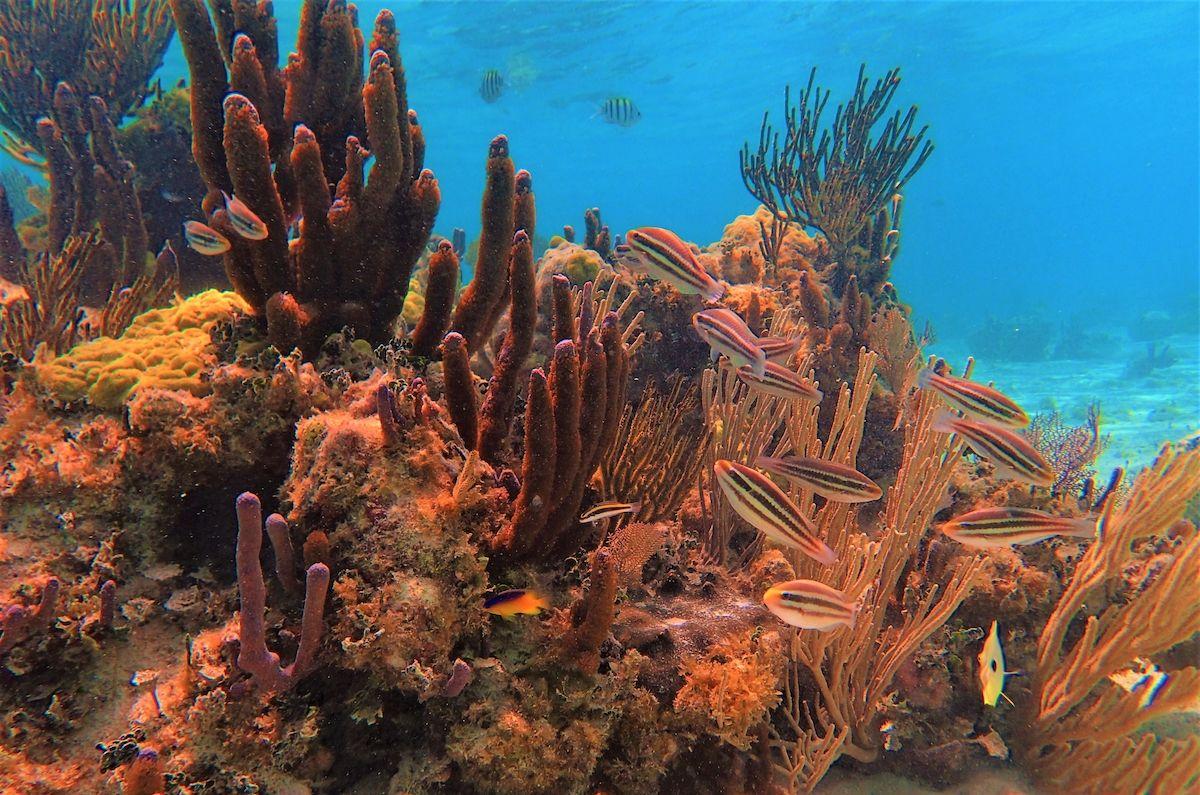Almost a third of the surface of the Mesoamerican Reef System is in critical health, due to the decline of fish and the proliferation of fleshy algae.
This was revealed by a preliminary report published by the Healthy Reef Initiative (HRI), based on monitoring carried out by 36 civil society organizations, between June and December 2021.
It is one of the most important coral reefs in the world, which extends for more than 1,400 kilometers off the Caribbean coasts of Mexico, Belize, Guatemala and Honduras. Hundreds of coastal communities depend on this ecosystem for their livelihood, because of the multiple environmental services it offers.
The Health Report considers four variables to determine if reef sites are in optimal condition: coral cover, presence of fleshy macroalgae, herbivorous fish biomass, and commercial fish biomass.
More is better when it comes to coral cover and fish populations, both herbivorous and commercial, but in the case of macroalgae, their presence is a negative indicator for reefs, as they threaten coral growth.
Herbivorous fish feed on macroalgae, so their decline almost de facto implies their growth.
On the other hand, the commercial fish population (snappers and groupers) provides an overview of the extent of overfishing.
To measure these variables, different ranges are used: Very Good, Good, Regular, Bad and Critical.
“Tracking changes in these indicators allows HRI researchers to evaluate which ones are of greatest concern in a given site, as well as in the entire SAM as a whole, and how to approach solutions to restore reef health,” the organization said.
The overall assessment of the 234 reef sites monitored in the four countries shows that 44% are in a “Poor” state of health, while another 31% are in a “Critical” state. Only 5% have a “Good” condition.
HRI researchers found only one site rated “Very Good” in Cozumel, Mexico. This site has been completely protected from all fishing for decades, and it shows: the biomass of groupers and snappers is five times greater than the regional average.
Fish monitoring covered about 140,000 square meters of reef; more than 64,000 fish were counted.
According to the organization, groupers and snappers once again had the largest decreases since the last report and are now at a critically low abundance throughout the SAM.
Only 55 of the fish counted in the 2021 monitoring were the largest grouper species, and only 12 of these groupers were actually large enough to reproduce.
The low abundance and small size of commercial and herbivorous fish reveal a critical need for greater protection and management of fisheries, primarily through a rapid and sustained increase in fully protected areas, as well as an increase in compliance with those protections, HRI said.
“Real protection must be absolute, as must our determination to enforce it. This is a problem with a direct and feasible solution, which will provide social and economic benefits, in addition to improving reef health,” said Melanie Mcfield, a coral reef scientist at the Smithsonian, an institution comprised of 21 museums in the United States.
To achieve a healthy reef, at least in a “good” state, it is necessary to increase the biomass of commercial fish and 49% of herbivorous fish by 142%. On the other hand, a 77% reduction in fleshy macroalgae, which grow on corals, is necessary.
For Melanie Mcfiel, it is advisable to dedicate 20% of the sea under total protection of all fishing to recover fish stocks inside and outside these areas.
The countries where the Mesoamerican Reef is located have designated more than 50 marine protected areas, which cover more than 50% of their territorial waters, but many still allow fishing, only 2.4% of the waters are fully protected.
“If we had designated 20% of the SAM under full protection 15 years ago when we first recommended this action, the region would now be reaping the benefits of more productive fisheries, better reef health and greater tourist value in fully protected areas,” MacField added
Living coral cover at study sites is under favorable conditions, requiring only a 5 percent increase for sites to reach “Good” status.
However, HRI warns that, in addition to the decline in fish populations, global climate change and disease outbreaks will continue to affect corals, while nutrient pollution continues to fuel the proliferation of macroalgae.



Comentarios (0)